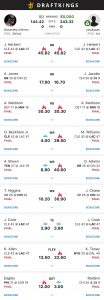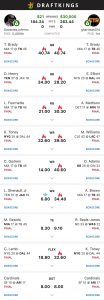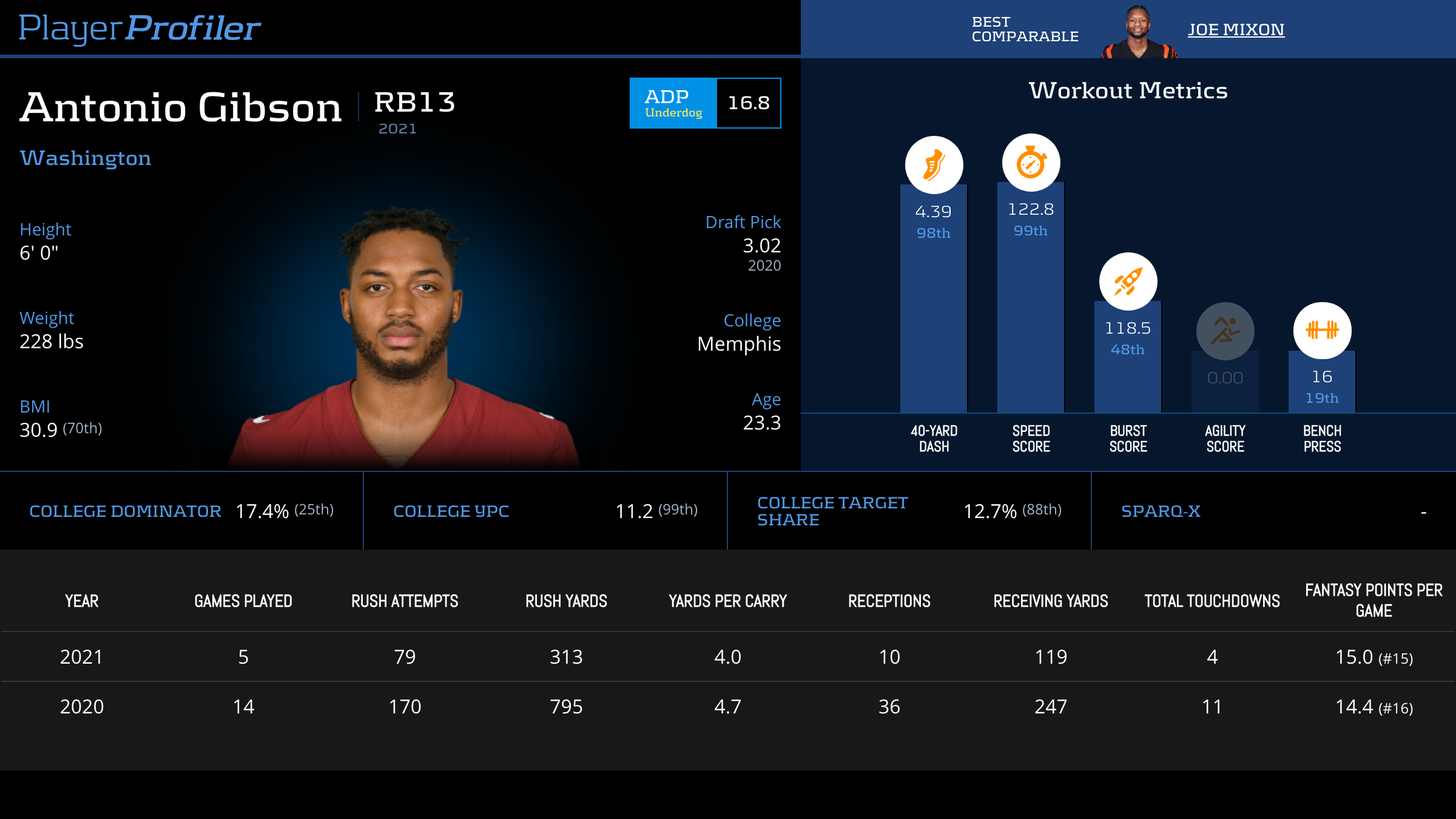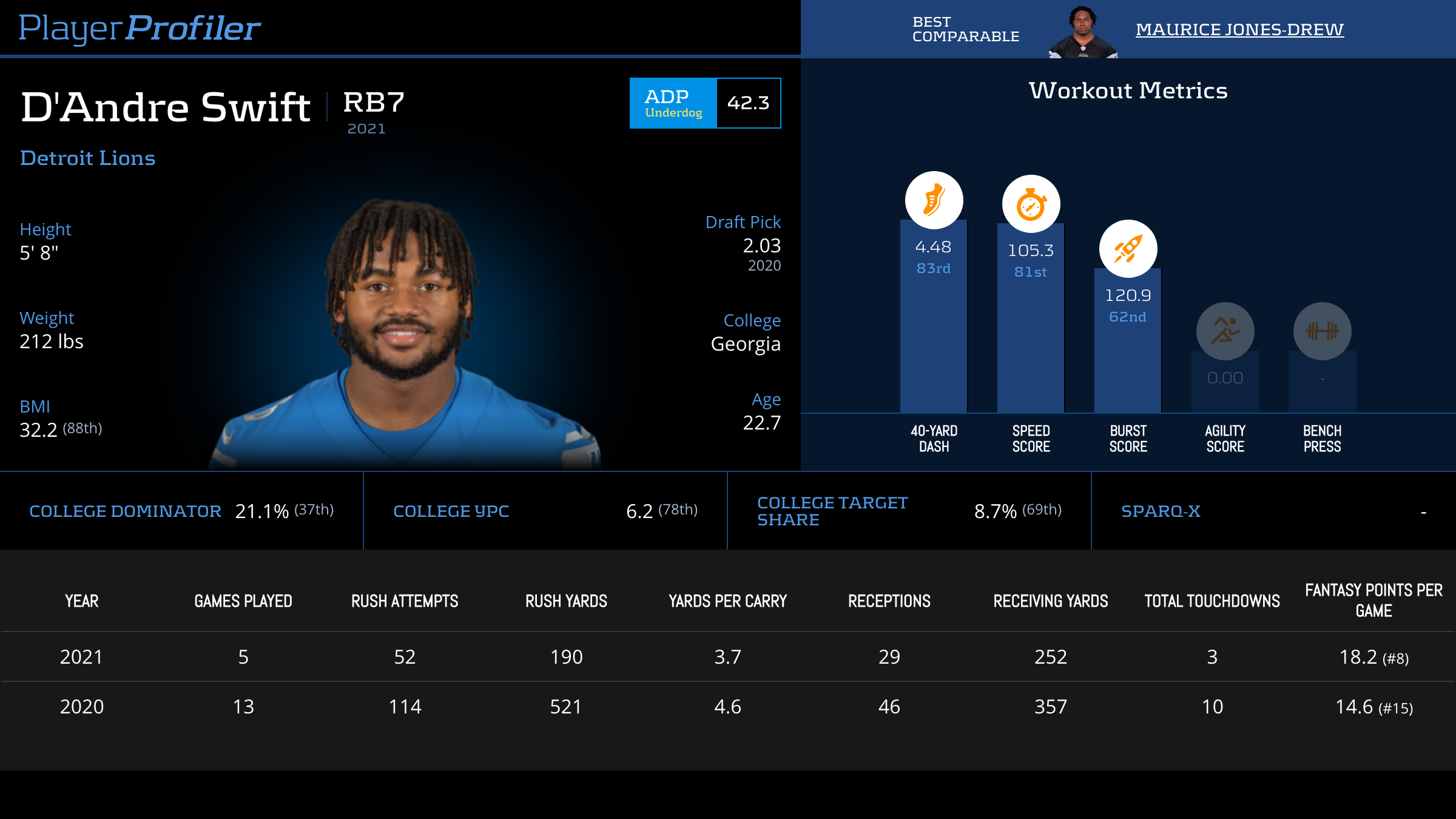If you read Week 5’s Pareto Principals, I would like to congratulate you on your profitable week.
Last week I used this column to declare Chargers-Browns my favourite game to stack, and implored you to play Mike Williams, Justin Herbert, and Nick Chubb. If you followed this advice over enough entries you would eventually have stumbled upon a winning combination of players.
Sadly, I wound up playing no such combination.
In this week’s edition of The Pareto Principals I’m going to spend more time than usual looking backwards. How come?
First, The most impactful decision of my day took place long after I published my column, based on the late scratch to Dalvin Cook. I want to walk through the last 90 minutes of my Sunday morning as a case study on the domino effect of DFS ownership. Second, there is a psychological burden to losing weeks; especially when elements of your process led you to the right plays. I want to practice the vulnerability that’s often missing in this space in hopes you can apply some of the same to your process. Lastly, I’ll discuss some of my featured plays for Week 6.
Final note as always: if this is your first time reading this column, I encourage you to check out my introductory article. This will walk you through my DFS process, what I aim to do in this column, and an explanation of plenty of terms I will use.
The Pareto Principals: Guiding Principles For Limited Entry DFS
Week 5 Review
As with each week, let’s start with an update on the yearly results. It continues to be a down start to the year, which I’ll address more openly this week.
Processing Downturns
The most anxiety-inducing element of NFL DFS is the sample size. You get just 20 main slates per year to realize whatever edge in expected value you have. The sample size is so minute that it’s easy for sharp players to come out behind or weaker players to come out ahead. In tournaments this is compounded by the fact that you’re always more likely to lose than win with each lineup. Thus far, I’ve eclipsed my goal of having more than 10-percent of lineups in the top 1-percent. I just need those to find the top 0.1-percent before the year concludes.
The question that gnaws at you after a losing streak – no matter the underlying results – is; Am I playing poorly or scoring poorly? In other words, should I fundamentally change my process?
This anxiety gets heightened when you’re being relied to give advice. Frankly, I feel more pressure to produce positive results for you than I do for myself.
Part of this is why I structure this column the way I do. The emphasis is on process and strategy rather than players. The strategies I discuss each week are scalable well beyond the slate at hand, and within each slate you could play different lineups than I do each weekend even if you follow my advice. Above all, I hope readers of this piece come away with a deeper understanding of probabilistic gaming they can apply to any players or games they find attractive.
While I often do lineup reviews, today I’m going deeper. I want to compare two my lineups with the winning lineup in its contest. While neither of mine were close to winning in score, I hope this exercise demonstrates just how close to a winning structure you can be, even in down weeks.
Line-up Comparison #1
The first lineup comparison is my entry into the $50 single entry chop block compared to youdacao’s winning entry. Despite an 80 point gap, you can see a lot of similarities. Each of us locked in Alexander Mattison, and played a Chargers double stack. Each lineup as a secondary correlation in Green Bay-Cincinnati.
He played the chalk packers piece in Davante Adams, while opting for the less popular chargers receiver. Among the two remaining pieces, he played one popular one off in Kadarius Toney, just as I did with A.J. Brown. He played a low-owned Josh Jacobs correlated with Raiders defense, while I played the low-owned Odell Beckham to correlate with my Chargers stack.
On the Sunday of this slate his lineup is better. But was that foreseeable? I think both are strong, and frankly it’s encouraging to see so many similarities between my entry and the winning lineup from a player I highly respect. The decisive difference here was my decision to prioritize Aaron Jones. I felt strongly about Jones as a core piece, and wrote last week about why building through mid-price running backs would lead to a unique build. This prevented me from playing the Adams side of this lineup and it gave me a unique enough build I felt comfortable locking in the more popular Keenan Allen instead of Mike Williams.
Ultimately, I think the decision to play Jones was viable, and the decisions I made subsequent made sense based on that stance. Running through this scenario is helpful to review my process each week and I wanted to share it with you. Let’s try one more.
Lineup Comparison #2
This was my sole ‘top one percent’ lineup, one of five entries played into the slant.
Once again you can see a lot of similarities between this lineup and the winner of the contest. Each of us played a Tom Brady stack, albeit I think mine was stronger in theory adding Leonard Fournette and Mike Gesicki as a bring back. This was one of my few non-Mattison lineups. I felt swapping to Fournette was viable in the context of the stack and preferred paying up for Derrick Henry than adding Mattison as my second cheap, chalk running back.
Having faded Mattison at 53-percent rostered, I was comfortable building a more chalk lineup elsewhere than usual. I played the same secondary correlation as the winner albeit pairing CeeDee Lamb with Kadarius Toney in place of Ezekiel Elliott. Laviska Shenault correlated with Henry, and at the the same price of Jaylen Waddle, I felt added a unique colour to the Tampa Bay-Miami stack.
My biggest regrets on this lineup are fairly meaningless to the result. First off, it’s too chalky even without Mattison. I had to make a lot of late adjustments after the news, and in a non-Mattison lineup probably should have opted for Elliott and Justin Jefferson rather than Henry and Lamb. This would have brought down my ownership and added more intentionality to the lineup by leveraging Mattison with Jefferson. But ultimately the path for this lineup to win was a better job of playing Buccaneers touchdown roulette with my stack partners. This is hardly an actionable process change.
Sunday Morning Butterfly Effect
We’re going heavy on looking backward this week but this is a strategy column, not a player picks column. Therefore, let’s forge ahead with one last reflection on the week that was. I discussed in the lead up to week 5 the factors leading to a dominant build.
- 1) Cheap Running Backs projected better than usual.
- 2) Few elite quarterbacks were available on the slate.
- 3) More people spending down at RB2 and quarterback would push ownership toward Davante Adams and Derrick Henry.
Each of these elements became even more prevalent when Dalvin Cook was ruled out leaving Mattison the clear-cut best play on the slate. How do you deal with such a game changing shift on Sunday morning? It’s important to stay mindful of the impact on construction across your contests. I made two errors; one results-oriented and one process-oriented that defined my negative day overall.
How Alexander Mattison Took Me Off Mike Williams
You may recall I recommended Mike Williams in this column; yet he did not enter any of my lineups. Here is how good process led to bad results.
When Mattison became the ultimate free square running back, I had to ask myself what the knock-on effect of an avalanche of Mattison teams would be. I diagnosed three changes based on how people would most logically swap into Mattison.
- 1) A large portion of Leonard Fournette and Damien Williams lineups would swap directly to Mattison.
- 2) Ownership on the mid-range running backs would fall even further with additional folks spending down to Mattison.
- 3) With so many strong point per dollar running backs, many players would play a running back over wide receiver in flex.
So how do you leverage this knowledge? In case 1, you play more Fournette and Williams. This was my least-preferred option, and I only did so in the Tampa Bay stack shown above. ‘Price leverage’ is the weakest form of contrarian strategy, because you wind up on the same construction as everyone else, albeit with a worse player.
I was already leveraging off point two, so this was a route I was excited to take. I wanted to play Mattison, but if I played him with low-owned stacks and a mid-range running back, It allowed me to remain unique. Combined with my projected increase of three-RB lineups, I was more comfortable rolling with Keenan Allen than I did prior. Projecting better than Williams and $700 less, I decided it was no longer necessary to force additional uniqueness if I could roster Allen at under 10-percent ownership. My process was correct here, and I’m happy with the Allen lineups I played. It just so happened Williams became the nut stacking partner for my most played quarterback and this move robbed me of a chance to compete for tournament wins.
It happens.
Owned By Ezekiel Elliott Once Again
You may be aware that I’m not the largest proponent of Ezekiel Elliott. That being said, I’ve been overweight on Elliott for most of this year until last week. Early on, he projected as the most popular mid-range running back and thus fell behind Aaron Jones and Nick Chubb in priority for my strategy. This should have been a pivot I made on Sunday morning, recognizing Elliott would also be the mid-range back most affected by folks shifting to Mattison.
I should have taken advantage of this, mixing in Elliott for some of my Lamb teams. This could have opened up the ownership to play Adams in place of Jones on these same teams and maintain stable ownership overall. In this instance, had I made this change I would have scored better AND I can say in hindsight it would have been superior process.
I hope this review exercise was helpful. It’s often easier to understand the strategic levers that go into lineup construction with the benefit of hindsight and I wanted to dive deep into that today. And now, a brief overview of my Week 6 game plan.
Week 6 Macro-Strategy
Injuries have ravaged the running backs position for a second straight week, allowing several backups to find feature roles. The super-charged ‘handcuff’ Kareem Hunt leads the pack, who is a viable play every week without injury, and now becomes the top play on the slate at $6200. My attitude with Hunt is similar to Mattison last week. He’s a Game Script-proof option in an elite environment. There’s no path to a comfortable fade. I will play Hunt in the vast majority of lineups, but often correlate him with DeAndre Hopkins. The star wide receiver has been off to a slow start, but sports Air Yards Shares of 47-percent and 73-percent over the last two weeks. Hopkins is back in business and provides an easy avenue to at least correlate my chalk play.
I’m significantly more comfortable fading the other ‘free square’ running backs this week; Khalil Herbert, Darrel Williams, and Devontae Booker. While all are strong point per dollar plays, you have to keep in mind the raw point ceiling required to win a tournament. Yes these players may ‘pay off’ their price with a 12 point week. I’d far rather use that spot to cycle through less popular options in hopes of finding a 20 point player and force these ‘free square’ lineups to chase me down.
Back To the Mid-Range
The tournament running back landscape – like the NBA – has abandoned the mid-range game. I don’t expect as large a hole in ownership as last week because we don’t have as chalky an option as Derrick Henry at the top end. Nonetheless, Travis Kelce will be a priority in many double-cheap running back lineups, and Austin Ekeler should garner popularity as the highest priced active running back in an excellent game.
My favourite mid-range back is D’Andre Swift. One of the league’s top receiving backs, Swift catches an excellent matchup this week in Cincinnati; a game I want both sides of.
4 of 5 teams who played the Bengals set or tied their season high in RB targets that week.
In total they’ve allowed 46 RB targets.
The only team in the NFL whose targeted their RBs more than 46 times?
The Detroit Lions, their week 6 opponent.
🔥🔥🔥 pic.twitter.com/4JH6Vp2T8j
— Jakob Sanderson (@JakobSanderson) October 12, 2021
It is going to be extra imperative to find structural ways to reduce your ownership this week with so much consolidation around the top games. Chiefs-Football Team and Ravens-Chargers are the clear-cut top games and injuries in both leave very few paths to differentiation within your stacks. Especially when playing those lineups, you need to implement structural leverage points to stay unique. Another favourite of mine is Antonio Gibson. We know the Chiefs can be ran on but Gibson is a risky play given the projected Game Script.
Sometimes it’s worth betting on unlikely outcomes in tournaments, especially when doing so on a player capable of creating those outcomes. The explosive Gibson provides a structural flip in the mid-range, and offers direct leverage off Terry McLaurin.
For One Week Only, I am a Cat Person
The last game I want to touch on today is Lions-Bengals. Among the non-chalk games, none excites me more than this contest. The Bengals have quietly emerged from their run heavy hibernation over the last two weeks, passing at the second-highest rate on neutral downs.
Bengals also quietly averaging the league's 2nd-highest pass play rate (66%) in neutral game script the past two weeks after opening the year with the 9th-highest run play rate through Week 3. https://t.co/RujkxdAoiv
— John Daigle (@notJDaigle) October 11, 2021
This is a trend I want to jump on before the market fully corrects. Play Joe Burrow with Tee Higgins, Ja’Marr Chase or both, and add D’Andre Swift as a bring back. You’ll set yourself up with a high-potential stack at tolerable ownership. Every week Swift is underpriced for his role and every week his ownership comes in at roughly 10-percent. The former Georgia Bulldog ranks No. 4 in Yards Created Per Touch, and No. 3 in RB Target Share. Swift’s snaps have increased the last two weeks, and he’s set up in a smash spot for Week 6.
The Final Word
After a heavy preview emphasis in Week 5, it was a more reflective Week 6. I’ll be back in Week 7 with a more standard version of the column. but I wanted to include you this week in the reverse-engineering I do to fine tune my process. As always, thank you for reading and see you next week!








